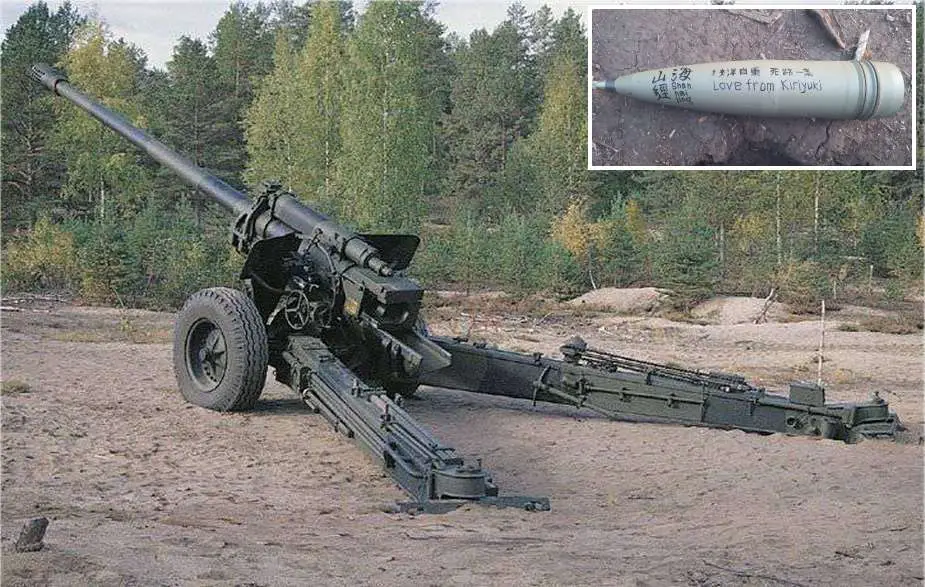On April 12, 2024, the British Government disclosed that Russia had breached UN resolutions by obtaining weapons from North Korea and Iran, which are currently being utilized by Russian military forces in Ukraine. According to the statement, Russia has acquired several dozen ballistic missiles and millions of artillery shells from North Korea. These armaments have been employed in assaults targeting Ukrainian civilian areas.
Follow Army Recognition on Google News at this link

According to pictures released on Russian social networks, Russian forces use Iranian ammunition for its M-46 130mm towed gun. (Picture source Russian social network VK)
Additionally, Russia has sourced thousands of Shahed drones from Iran, deploying them in a strategic offensive against Ukraine’s power infrastructure. This campaign aims to force Ukraine into submission by cutting off electricity supply, thereby leaving civilians without power and heat.
In a report by Reuters in February 2024, it was revealed that Iran has supplied Russia with a significant number of potent surface-to-surface ballistic missiles, including roughly 400 missiles from the Fateh-110 series, such as the Zolfaghar, which are known for their short-range capabilities.
The shipments began in early January 2024 after a deal was finalized in meetings late last year between Iranian and Russian military and security officials that took place in Tehran and Moscow, one of the Iranian sources said.
The Fateh-110 is a short-range ballistic missile developed by Iran. First introduced in the early 2000s, the missile is primarily designed for ground-to-ground operations and is known for its solid-propellant and high precision in hitting stationary targets. This missile system has been developed over several generations, with improvements in range, accuracy, and payload capabilities. It's part of Iran's arsenal to deter regional adversaries and assert its military capabilities. The Fateh-110 can carry a conventional warhead and is reputed for its mobility and quick deployment capabilities, which make it a significant component in Iran's strategic military assets.
Over the past decade, the defense relationship between Iran and Russia has deepened, characterized by significant military cooperation and strategic alignment, particularly as both countries face similar pressures from Western sanctions and diplomatic isolation. Russia has emerged as a critical supplier of military technology and hardware to Iran. This includes high-profile deliveries like the S-300 air defense system, which Russia provided after years of delay due to international pressure. The two nations have also cooperated in the development and production of other military equipment, including more advanced defense systems.
Beyond arms sales, Iran and Russia have found common ground in regional conflicts, particularly in Syria. Both countries have supported the Assad regime, both politically and militarily, against rebel groups and Islamist militants. This cooperation has extended to joint military exercises and strategic planning, underscoring a shared interest in stabilizing the region in ways that align with their respective security and geopolitical objectives.
Iran's support for Russia in the context of the war in Ukraine has been significant and multifaceted, particularly emphasizing military assistance through the provision of drones and other weaponry. Over the past couple of years, Iran has emerged as a pivotal defense industrial partner for Russia, supplying loitering munitions that have augmented Moscow's capabilities in its strategic air campaign against Ukraine. This support has been critical as Russia faced shortages in its own drone supplies. Notably, Iran has supplied Shahed-191 and Shahed-129 unmanned combat aerial vehicles (UCAVs), along with Mohajer-6 drones, which are primarily used for intelligence, surveillance, target acquisition, and reconnaissance missions (FDD).
This military cooperation marks a deepening strategic alliance between Iran and Russia, which has rapidly evolved since the onset of the conflict in Ukraine. This relationship includes the deployment of Iranian military personnel in Crimea to train Russian forces in the use of these drones. Such cooperation has been crucial for Russia as it utilizes these Iranian drones to target both military and civilian infrastructures in Ukraine (The Iran Primer).
The relationship between Iran and Russia has thus shifted to a more robust defense partnership, with significant implications for the conflict in Ukraine and broader regional dynamics. This partnership includes potential collaborations beyond just drone technology, possibly extending to joint development in missile technologies and other military equipment
Defense News April 2024
















